

by John Helmer, Moscow
@bears_with
Armenia has lost the October war with Azerbaijan because of Armenian failures in battlefield intelligence, obsolete defences, and the political miscalculations of Prime Minister Nicol Pashinyan (lead image). His only allies now are the mountains and the weather.
This is the consensus this week of Moscow’s leading military analysts. “During the period of Nikol Pashinyan’s premiership,” Vzglyad reported the Russian General Staff assessment on Tuesday, “three intelligence chiefs were replaced, and one of them had no competence and was a purely political appointee from the West. All this was accompanied by internal anti-Russian rhetoric, multiplied by national arrogance. Some leaders of Nagorno-Karabakh have said things like ‘we don’t need the Russians at all, we can walk to Baku without you.’”
“Moreover, over the last six months, in the General Staff of Armenia there has been a mass dismissal of officers who were trained in Moscow.”
“It’s probably about time that real purges within the government took place,” Pashinyan had announced in April. According to the Russian assessment, Pashinyan then made the nervous novice’s classic mistake: he reinforced his palace guard against rival Armenians, but underestimated his traditional Azeri enemy and has now lost control of territory.
The Armenian riposte is that Moscow analysts who say this “receive money from Turkey and Azerbaijan.”
“Why was the Armenian army weaker and what mistakes did it make when preparing for combat operations?” reported Yevgeny Krutikov, Vzyglyad’s military analyst with close ties to Russian military intelligence. “October 27 is the significant date, since the pace of the Azerbaijani army’s offensive was calculated for this month. These rates were not met, and in some areas they failed altogether. The main political tasks for Baku have not been solved as well.”
“Nevertheless, the Azerbaijani armed forces achieved a number of successes, broke the defense line in Nagorno-Karabakh and advanced tens of kilometers. By Saturday, October 24, the defense of the Armenian forces in the southern sector of the front was hanging by a thread and could have been destroyed with disastrous consequences for Armenia. This did not happen, but the situation itself gave reason to talk about the strategic defeat of the Armenian troops. Although these arguments were premature, the results of the first month of the war are not very encouraging for Armenia and Nagorno-Karabakh (NKR).”
“If you look at the map of the region, the main direction of a possible strike by Azerbaijan on the NKR looks like the central zone along the Karkarchay [Karkar] River. Just go directly through the ruins of Aghdam to Khojaly and then to Stepanakert. It was in this area that the main line of defense of the Armenians was organized for a quarter of a century. But it was in the central sector that the Azerbaijanis did not even try to imitate the offensive. There is an intense artillery duel on this front, but nothing more. But the Armenian side is forced to constantly keep large forces in the central sector, which in another scenario could be used, for example, to organize pockets in the South.”
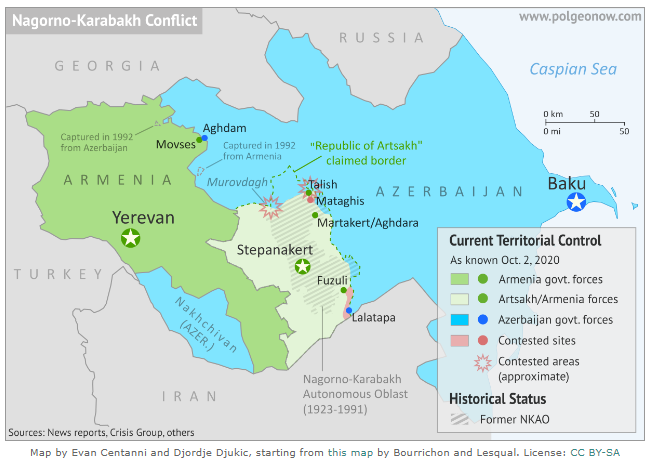
Source: https://www.polgeonow.com/
According to the analysis agreed on by the Russian General Staff, the first big mistake the Armenians made was the intelligence failure in underestimating the effectiveness of the Azerbaijani forces’ combination of highly mobile drone missiles and rockets with long-range howitzers. “Armenia and the NKR should have thought about what was happening in the summer, when sporadic skirmishes began almost along the entire front line…. Azerbaijan gradually formed two shock corps, which brought together the most combat-ready parts of the entire army, including parts of the deep reserve. Warehouses were built closer to the contact line, and the fuel supply system was supplied. All this could be seen simply through binoculars, without resorting to complex intelligence manipulations.”
“In addition, the Armenian intelligence did not inform the political leadership of the country of the correct assessment of what weapons, in what quantity and why Azerbaijan has been buying. Based on analysis of these purchases, Armenia and the NKR could have built a model of military tactics that Baku was preparing to use, and organize counteraction to it. First of all, this applies to imported drones (UAVs) and the self-propelled artillery supporting the advancing battalion-tactical groups (BTG). This alone would be enough for the Armenian military to understand what was being planned on the other side of the front.”

Left, the Turkish-supplied Bayraktar (“standard bearer”) drone; right, Azerbaijani Defense Ministry video showing a drone attack on Armenian tanks. Source: https://www.forbes.com/
There has been no Russian confirmation of western reports that Russian Army electronic countermeasures (ECM) have been deployed to assist the Armenian side to neutralize the Azerbaijani drones.
The second big mistake of the Armenians was to present obsolete, fixed-point and insufficient numbers of air defence units, adequate against a manned airforce attack from the Azeri side, but “useless” against Israeli and Turkish drones. “There are simply not enough air defense systems in the NKR, and there are very, very many UAVs in Azerbaijan. The Armenian side on the ground is suffering heavy losses from the actions of UAVs, especially since the Azerbaijanis purposefully knocked out the positions of the Armenian air defense systems with missiles and long-range artillery… For what reason Yerevan did not bother to re–equip the air defense system and create its own group of drones, this is a question more psychological than purely military.”
The obsolescence of the Armenian combat equipment reflected also their outdated fighting tactics. “The NKR defense system was based on several consecutive fortified lines, the most advanced of which in the central and southern sectors was built in the 1990s in the plains zone as part of a so-called security belt. This defence worked well for 25 years. But over a quarter of a century, Azerbaijan and its army have changed a lot. But nothing has changed in Karabakh and Armenia, including in terms of their perception of military reality. In the new situation, it was necessary to hold the plains zone of the security belt by other measures and methods. Otherwise the prospect of losing Jebrail, Fizuli, Hadrut, Zangelan and Kubatly were visible to the naked eye. Which is what happened in the end.”
“Now Azerbaijani troops in the southern sector have reached the second line of defence and by last Saturday they were critically threatening the ‘Lachin Corridor’ – this is the the main supply road from Armenia. The loss of Lachin, which was 10 to 15 kilometers away in a straight line for the Azerbaijanis, would have been a truly strategic disaster for the Armenians. In addition, the loss of a significant territory in the south right now means serious political problems and moral defeat for Armenia. It is the advance in the south that Baku can record as its main victory and main political achievement after a month of fighting in Karabakh.”
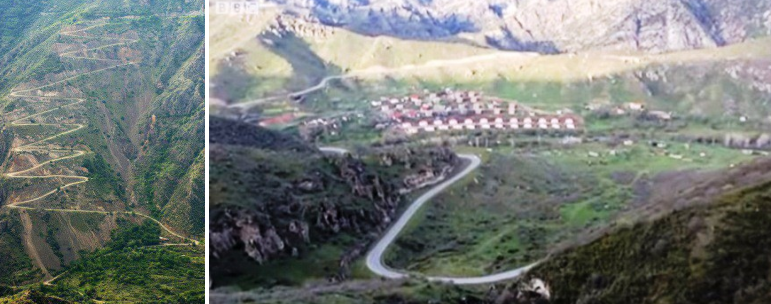
The Lachin Corridor road – left, Wikimapia, 2018; right, drone picture from the Azerbaijan Defense Ministry. https://en.axar.az/
Since the weekend, in the most recent fighting in the gorge and mountainous terrain of the Lachin Corridor, however, this Azerbaijani combination of weapons is inadequate. “Sometimes even primitive methods of protection in the mountains are very effective. For example, in the gorges around Lachin and Shusha, steel cables have been stretched since the late 1990s, which completely excludes the use of assault aircraft or drones there.”
The Moscow assessment blames the military defeat of the Armenians on the ground to Pashinyan’s anti-Russian strategy since he took power in May 2018. That was an operation, he told the US press at the time, which had “no geopolitical context to our movement, our velvet revolution.”
“Over the past year, the Armenian military lost contact with Moscow, and all contacts in the intelligence sphere between the two countries were curtailed – and this was done at the initiative of the political leadership of Armenia. During the period of Nikol Pashinyan’s premiership, three intelligence chiefs were replaced, and one of them had no competence and was a purely political appointee from the West. All this was accompanied by internal anti-Russian rhetoric, multiplied by national arrogance…Moreover, over the last six months, in the General Staff of Armenia has been mass dismissal of officers who were trained in Moscow. The ostensible reason for this was the wedding of the Chief of the General Staff’s daughter, who allegedly ‘did not follow the rules of conduct in the coronavirus pandemic.’”
Pashinyan’s rationale for the dismissal of General Artak Davtyan was announced on June 8. At the same time he also sacked the chiefs of the police and national security administration. That, according to the Russian assessment, left Pashinyan in charge of a command-and-control system which was hollow. The Azerbaijan President Ilham Aliyev saw the opportunity to strike. “It seems that the Armenian General Staff either did not have a mobilisation plan at all, or it suffers from a number of strange features. For the defence of the ‘mountain fortress’, forty to sixty thousand people are really enough, but this is clearly not enough for the organisation of mobile defence. Armenians behave passively, simply fending off threats as they emerge.”
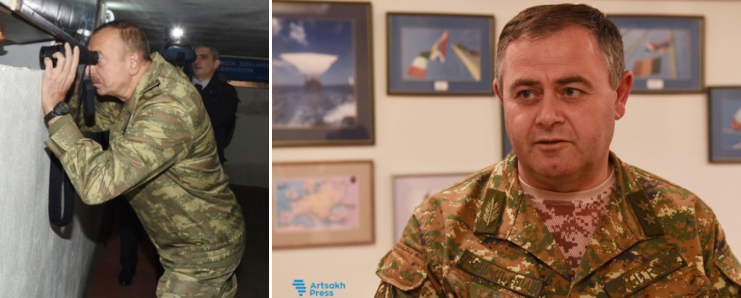
Left: President Ilham Aliyev on a front-line visit in November 2016. Right, On September 5, 2020, General Artsak Davtyan in Stepankert, capital of Artsakh, the Armenian-ruled territory of Nagorno-Karabakh. “I assess the situation as stable, calm. At the same time, I’m confident that the armed forces are ready at any moment to accomplish the tasks set before them,” Davytan said then.
“The Azerbaijani side (and the Turks behind it) have full operational initiative,” reported Vzglyad yesterday. “They can afford to redeploy forces along the entire front line, form new groups, replenish reserves, and initiate new plans. The Armenians, having lost most of their ‘security belt’ in the south, can no longer think about any counter-offensive operations. Especially about regaining the territory lost in the past month. In general, this is, of course, a military-strategic impasse for Armenia and the NKR. Azerbaijan will use the political breathing space for redeployment, replenishment of units and the development of new offensive plans. The Armenians are now ready only for passive defence.”
According to the Kremlin record, this year President Vladimir Putin has had seven telephone conversations with Pashinyan. After the war began on September 27, there have been four calls, each at Pashinyan’s insistence. Putin refused to cast blame on either the Azerbaijan leadership, or on the Turks for their support of Aliyev. The Kremlin communiqué records Putin agreeing with Pashinyan in their “serious concern over the incoming information on the involvement in hostilities of militants of illegal armed units from the Middle East”.
Pashinyan stopped telephoning Putin after October 5. At that point, Putin was “emphasis[ing] the urgent need for a ceasefire.” Putin then delegated the talking to the Foreign Ministry.
Foreign Minister Sergei Lavrov has spoken several times by telephone with the Armenian Foreign Minister Zohrab Mnatsakanyan, and their Azerbaijani counterpart, Jeyhun Bayramov. They also met directly in Moscow on October 9; then again directly but separately on October 20-21.

Direct negotiations in Moscow on October 9 between (left to right) Azerbaijani Foreign Minister Jeyhun Bayramov; Sergei Lavrov and Armenian Foreign Minister Zohrab Mnatsakanyan. Lavrov’s ministry issued no communiqué after the six-hour session.
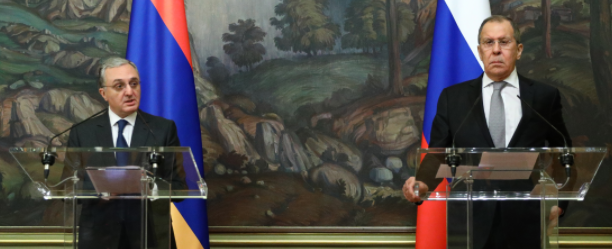
Left, Armenian Minister Mnatsakanyan with Lavrov in Moscow, October 12.
In Moscow on October 12, after his meeting with Mnatsakanyan, Lavrov emphasised the Russian role of impartial mediator at the diplomatic level, and also on the battlefield: “As for Russia’s continuing participation in the settlement process, we will be actively involved in this, both as one of the third co-chairs of the OSCE Minsk Group and simply as a close ally and strategic partner of our neighbours. I think that our joint overnight vigil, which produced a very important document, was not in vain and we will still be able to overcome the situation ‘on the ground’ very soon. At any rate, we are interested in this just as much as the confronting sides ‘on the ground’ are.”
On the same day Russian Defense Minister Sergei Shoigu spoke by telephone with the Turkish Defense Minister, Hulisi Akar. The curt press release in Moscow indicated that Shoigu had spoken of “stabilisation”; that was a warning to the Turks not to escalate their presence on the battlefield, either with their Syrian proxies or with Turkish military personnel. This was followed by Shoigu’s contacts with his counterparts in Baku and Yerevan to discuss their willingness to accept a Russian role in implementing and observing a ceasefire mechanism. There was no agreement, however, and in the intervening fortnight the Armenians have continued to lose ground.
Lavrov has spoken more often with the Turkish Foreign Minister, Mevlut Cavusoglu; in fact, five times over the past month. In their last conversation on October 27, they agreed on “the need to ensure a sustainable ceasefire between Armenia and Azerbaijan as soon as possible. Both ministers stressed that there is no alternative to a peaceful resolution to the problem, and called for an immediate ceasefire and resumption of negotiations through the established OSCE Minsk Group mechanisms. The sides specifically noted that internationalising the crisis through the involvement of foreign fighters was unacceptable.”
Igor Korotchenko, editor of National Defence Magazine in Moscow, confirms that the Azerbaijani tactics have been successful on the plains and in the valleys, but their advance has stopped in the mountains of Lachin. “Lachin was a failure of the Azeris. The main reason was local terrain. The well-prepared (for about 20 years) defensive positions of the Armenian army on the plains were penetrated by the Azeri army but the mountains have become a great difficulty for them, even for special troops. The Azerbaijan army is the more trained and prepared, partly with Turkish and Russian help.”
Korotchenko was asked if he can confirm whether Russian electronic countermeasures (ECM) systems like the Krasukha have been used to attack the Bayraktar. According to this October 21 report, “sources at BulgariaMilitary.com in the Russian Ministry of Defense claim that since the start of hostilities in Nagorno-Karabakh, Russian electronic warfare systems have been brought into full combat readiness, but have only now been used, as there has been no such saturation of drones in the area of the military base. Photographs of some of the downed Turkish drones and their fuselages show that these drones were indeed removed by an electronic warfare system, as there are no traces of a missile strike or other firearm.” In fact, the report originated from Yerevan.
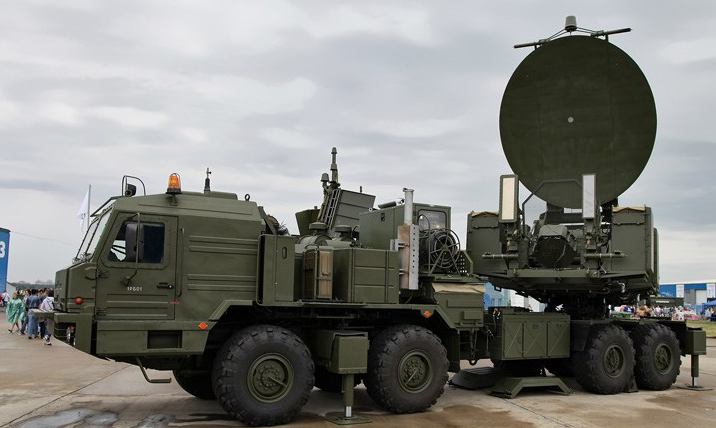
In Moscow Korotchenko responded: “For the last year Armenia has lost its contacts with Russia in the military sphere, so it is hard to say anything about [the Krasukha]. We can definitely say that Russia is interested in the diplomatic settlement of the conflict as soon as possible. It’s too early to talk about the lessons for both sides. Azerbaijan is using very effective drones plus artillery tactics, but the new terrain will require them to make some changes.”
Ilya Kramnik, a military expert at the Russian International Affairs Council, believes that “even after their latest failure, the Azerbaijan forces continue in control of the Lachin Corridor, because their drones and artillery can be still used for blocking the passage for Armenian troops. But the terrain and the unstable autumn weather will play for the Armenian army, which has experience of war in such conditions.”






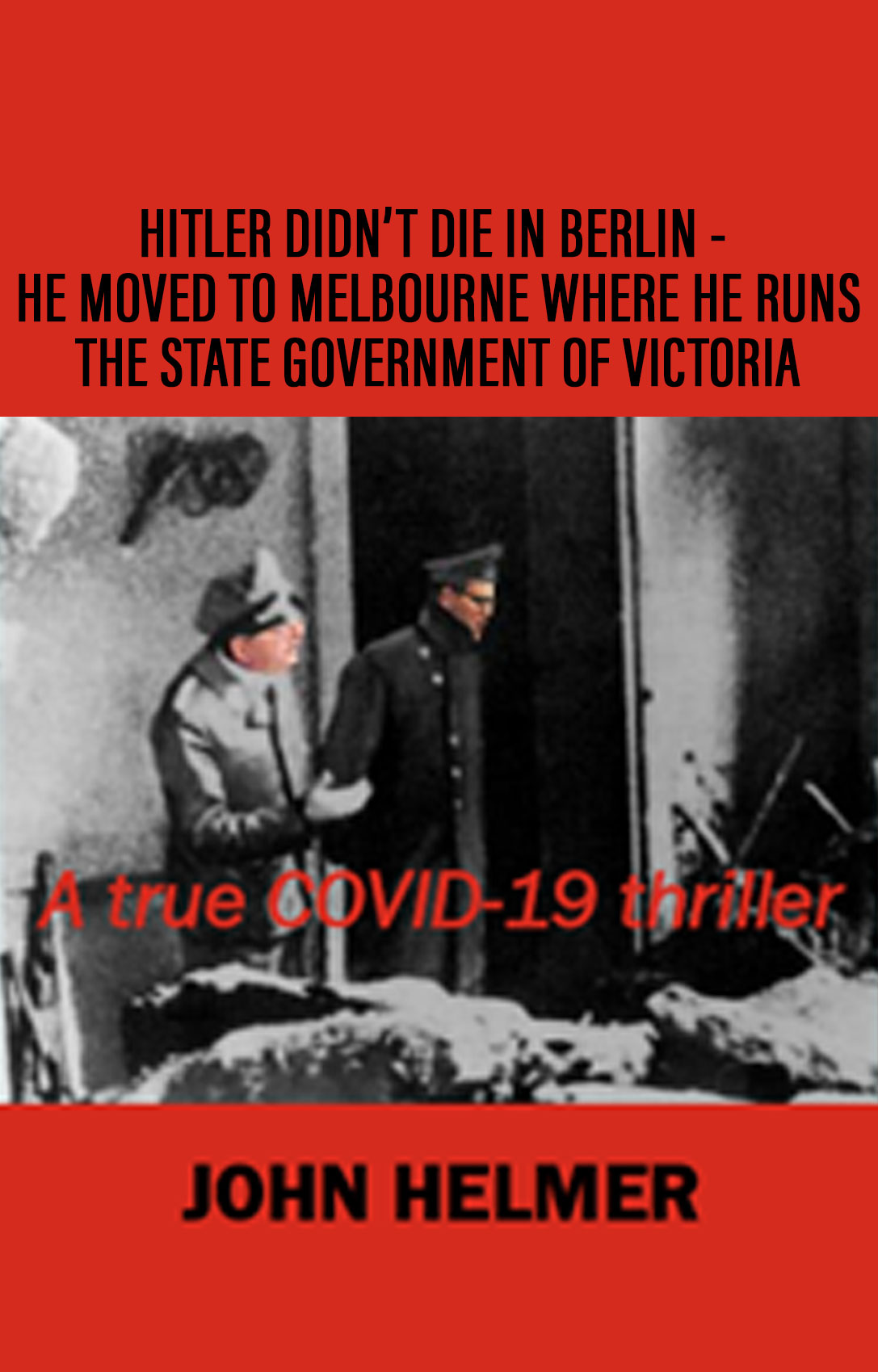




Leave a Reply